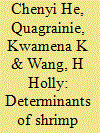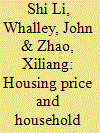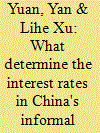| Srl | Item |
| 1 |
ID:
121803


|
|
|
|
|
| Publication |
2013.
|
| Summary/Abstract |
This paper intends to give a nuanced interpretation 'the middle income trap' in the discussion on China's economic future. A developing nation gets 'trapped' when it reaches a relatively comfortable level of income but cannot take the step into the next level. In this paper, the usually made connection between income trap and the structure of economy is critically examined and the 'trap' is interpreted as a bearer of information in itself. According to the Austrian school of economics (Hayek), prices represent the sum of information that is available to the markets. Stagnating incomes will consequentially be read as information concerning the lack of growth of the productivity of the work force and the industry. The 'middle income trap' has to be addressed at microeconomic level, focusing on the increase of productivity. Usually, the trap cannot be addressed by government policies, but has to be solved by increased entrepreneurship.
|
|
|
|
|
|
|
|
|
|
|
|
|
|
|
|
| 2 |
ID:
121806


|
|
|
|
|
| Publication |
2013.
|
| Summary/Abstract |
Shrimp farmers in the USA are facing the situation of increased imports resulting in reduced market share, falling prices, and reduced profitability for their farm-raised shrimp. The study examined the determinants of shrimp imports from China, Vietnam, Thailand, and Indonesia using an augmented gravity model of international trade. The results reveal that US imports from the four exporting countries are significantly affected by the GDP of exporting countries, GDP of the USA, exchange rate, unit import value (proxy for import price) of shrimp, and tariff. Tariff policy has implications for the US shrimp industry.
|
|
|
|
|
|
|
|
|
|
|
|
|
|
|
|
| 3 |
ID:
121802


|
|
|
|
|
| Publication |
2013.
|
| Summary/Abstract |
This speech introduces O'Brien's research approach to the divergence debate and presents the fiscal capacities of the states as the key condition for ushering in modern economic growth in the pre-industrialization West. The concerns of pre-modern European states (1415-1839) were not with economic development, but with external security and internal stability of their kingdoms. Mercantilism prepared European states for capitalist industrialization. Historical evidence supports the hypothesis that effective command and control over sovereign revenues were what gave Britain and other European states the advantage over their oriental counterparts in providing public goods of external security and internal stability, which made the divergence in economic development inevitable.
|
|
|
|
|
|
|
|
|
|
|
|
|
|
|
|
| 4 |
ID:
121805


|
|
|
|
|
| Publication |
2013.
|
| Summary/Abstract |
This article investigates the effect of house prices on household savings rates in urban China employing the 2002 and 2007 data of the Chinese Households Income Project (CHIP). We find that the rapid appreciation of house prices cannot explain high Chinese households' savings rates and the rising of Chinese savings rates. On the contrary, we find a negative relationship between house prices and household savings rates for home renters and homeowners. We do not find any evidence of 'savings for housing purchase' for young home renters when house prices increase. Their savings rates declined during housing market booms in recent 10?years. Savings rates of homeowners possessing multiple housing have decreased more because of 'the pure housing wealth effects.'
|
|
|
|
|
|
|
|
|
|
|
|
|
|
|
|
| 5 |
ID:
121804


|
|
|
|
|
| Publication |
2013.
|
| Summary/Abstract |
The interest rate is one of the most important factors in farmers' decision-making of borrowing and lending in the informal financial market in China. This paper explores the determinants of the interest rate with microfinance data. Results show that the income disparity, the relationship between borrowers and lenders, the usage of borrowing, and formal credit constraints are important factors affecting interest rates. More importantly, to borrow from those in the higher income hierarchy, farmers have to bear higher interest rates. We attribute this to different social capitals across income groups and higher default risks for the poor. This paper contributes to a better understanding of the informal financial market in rural China and sheds light on the mechanism of higher informal interest rate formation.
|
|
|
|
|
|
|
|
|
|
|
|
|
|
|
|